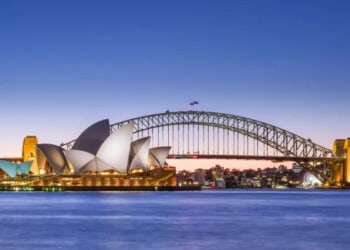The Challenger-3’s impressive accoutrements ignore the fact that the British military cannot reliably produce this tank in a timely manner—or in the quantity that it believes it requires.
Britain’s military is a mess. It is poorly staffed and barely funded—and, with diminishing American support, threatening a war with Russia by stationing “peacekeeping” troops in Ukraine. Something must give.
To keep pace with the challenges of the modern battlefield, notably the threat that Moscow poses, the British Ministry of Defence (MoD) has embarked upon a program to replace their aging Challenger-2 Main Battle Tank (MBT). Its successor, the Challenger-3, is being developed by Rheinmetall BAE Systems Land (RBSL), a joint venture between the UK-based BAE Systems and the German firm Rheinmetall. It represents a significant evolution for the British Army’s capabilities. Yet, as with so much of the modern British military, the production of these new MBTs is severely limited, costly, and will likely end in disaster.
Britain Just Can’t Build an Affordable Tank
Back in the early 2000s, the Ministry of Defence recognized the need to extend the service of the Challenger-2 through the Capability Sustainment Programme (CSP). British policymakers planned for the upgrades to be completed by 2020. Funding, however, dried up. By 2014, the CSP was restructured into the Challenger-2 Life Extension Programme (LEP), focused on replacing obsolete components of the preexisting Challenger-2 fleet and extending the aging tank’s service life to 2035.
This situation improved after BAE Systems and Rheinmetall submitted competing prototypes for evaluation in 2018-19. The program was further streamlined in 2019 when the two projects were merged into one. From there, Rheinmetall’s superior proposal formed the basis of the decision not to upgrade the Challenger-2, but to replace it outright. By 2021, MoD awarded the RBSL joint venture a contract for around $1 billion, with an estimated whole-life cost of about $2.6 billion.
But, in the typical fashion that has come to define the sclerotic British defense industrial base, the program has struggled through massive delays and extreme cost overruns. Still, British taxpayers has been committed to the expense for good—and both the former and current governments have given it their full support. So, for better or worse, the Challenger-3 is on track for initial operating capability in 2027 with a full operational capability by 2030. Its service life is intended to last until 2040.
The Specifications of the Challenger-3 Tank
Challenger-3s will possess a Rheinmetall L55A1 smoothbore gun, aligning with both UK and NATO standards. The new L55A1, unlike the original 120mm L30A1 rifled gun of the Challenger-2s, is similar to the guns found on the German Leopard-2 MBTs and the M1 Abrams—increasing interoperability between these systems.
Guns on the Challenger-3s, therefore, will have higher muzzle velocities and compatibility with advanced ammunition, such as armor-piercing fin-stabilized discarding sabot (APFSDS) roundsand programmable airburst munitions. And the British, like the Germans, have given up on depleted uranium shells and are instead developing tungsten-based Enhanced Kinetic Energy (EKE).
Critically, an entirely new system of modular armor is being made available on the Challenger-3s. These include EPSOM and Farnham armor, designed by the UK’s Defence Science and Technology Laboratory (DSTL). This bolted, modular design enhances crew protection and simplifies repairs and upgrades, addressing future anti-armor threats.
The tank integrates Rafael’s Trophy Active Protection System (APS), which detects and neutralizes incoming missiles and rockets—a critical feature given the proliferation of anti-tank threats, most notably drones, in the ongoing Ukraine War.
Laser warning systems and electromagnetic testing to ensure resilience in sensor-saturated battlefields round out the self-defense capabilities of the Challenger-3.
The tank’s fully digitized architecture includes a “digital backbone” for interoperability with other platforms, such as the Ajax and Boxer vehicles, enabling real-time data sharing in multi-domain operations. Upgraded commander and gunner sights, supplied by Thales, provide day-and-night targeting with automatic target tracking and wide-area search capabilities, enhancing situational awareness.
Britain Should Build Drones, Not Tanks
But the Challenger-3’s impressive accoutrements ignore the fact that the British military cannot reliably produce this tank in a timely manner—or in the quantity that it believes it requires. Already, the original order of 227 units has been reduced to around 148. And there is no guarantee that Britain will even be able to meet this reduced number. In the meanwhile, many British Army officers are speaking out and warning that 148 units for a MBT, with what British policymakers want to use these tanks for, is wholly insufficient to sustain modern combat operations.
It would seem that Britain has made a poor investment in the Challenger-3. The lessons of the Ukraine War have shown the benefits of investing instead in an army of unmanned systems. Alas, Britain has made the wrong choice.
About the Author: Brandon J. Weichert
Brandon J. Weichert, a Senior National Security Editor at The National Interest as well as a contributor at Popular Mechanics, who consults regularly with various government institutions and private organizations on geopolitical issues. Weichert’s writings have appeared in multiple publications, including the Washington Times, National Review, The American Spectator, MSN, the Asia Times, and countless others. His books include Winning Space: How America Remains a Superpower, Biohacked: China’s Race to Control Life, and The Shadow War: Iran’s Quest for Supremacy. His newest book, A Disaster of Our Own Making: How the West Lost Ukraine is available for purchase wherever books are sold. He can be followed via Twitter @WeTheBrandon.
Image: Shutterstock / Martin Hibberd.
















